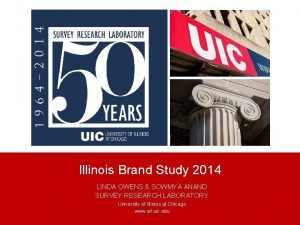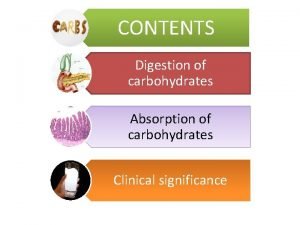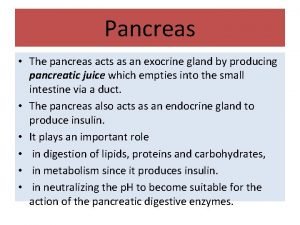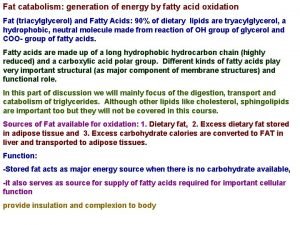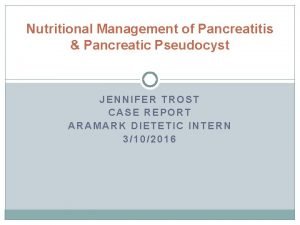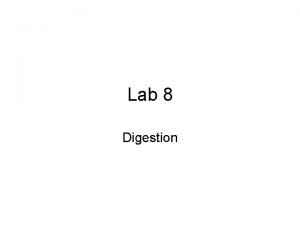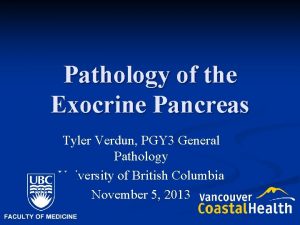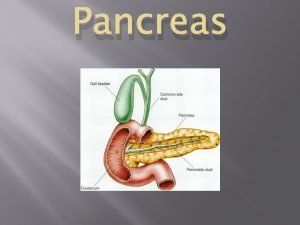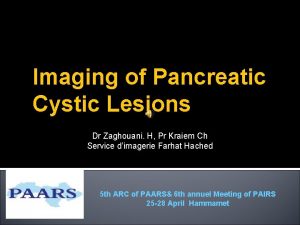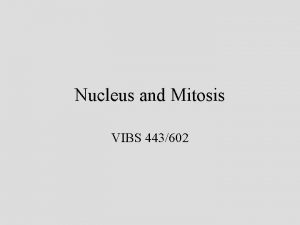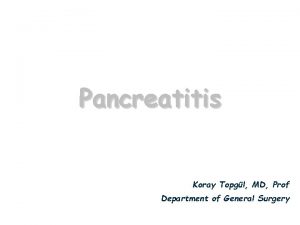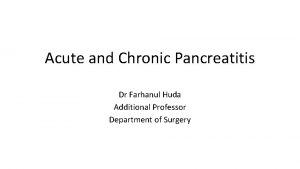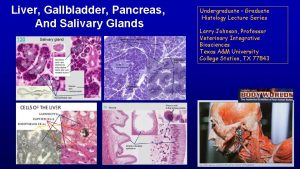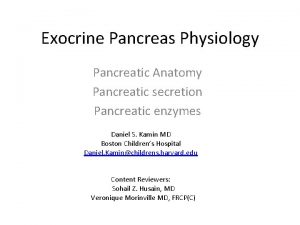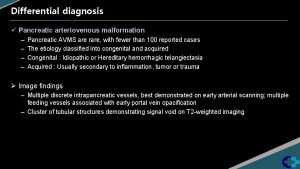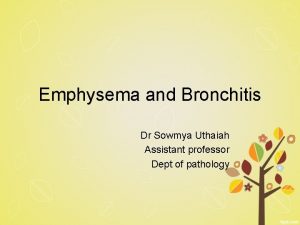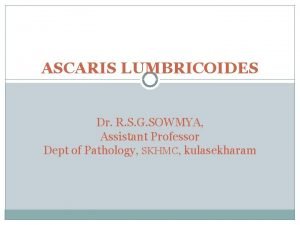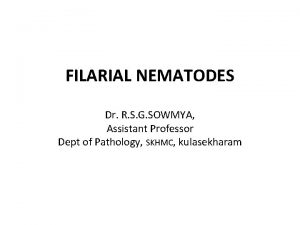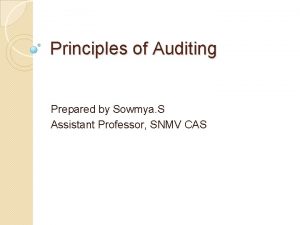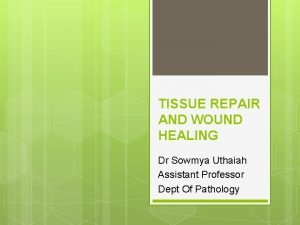PANCREATIC PSUDOCYST Dr R S G SOWMYA Assistant


























- Slides: 26

PANCREATIC PSUDOCYST Dr. R. S. G. SOWMYA, Assistant Professor Dept of Pathology, SKHMC, kulasekharam

DEFINITION Pseudo cyst is a collection of fluid containing pancreatic enzymes, blood, and necrotic tissue occurring outside the pancreas. The capsule is a non-epithelialized wall consisting of fibrous, granulation tissue usually develops within several weeks after the onset of pancreatitis / Trauma

Pancreatic Pseudocyst ↓ Beningn & Malignant Serous Cystadenoma Fibroma Lipoma Adenoma CA Pancreas

Pathology & Pathogenesis Pseudocyst situated within / adjacent to the pancreas Solitary, Unilocular, 10 cm in diameter enclosed with thin/thick wall • can also be single or multiple, though multiple cysts are more frequently seen in patients with alcoholism • the condition seems to stem from disruptions of the pancreatic duct – occurs due to pancreatitis and/or extravasation of enzymatic material

• Most commonly occurs following acute pancreatitis and abdominal trauma but can also occur due to chronic pancreatitis – abdominal trauma is the more common cause in children

Micro – Evidence of Haemorrhage & Necrosis – Deposist of Haemosiderin pigment (calcium and cholesterol pigment) – No Epithelial Lining – Contains Serous / Turbid Fluid

Clinical Features v Abdominal mass – pain v Intra peritoneal Haemorrhage v Generalised Peritontis

Associated conditions • Acute pancreatitis alcoholism gallstone • Chronic pancreatitis • Abdominal trauma

Symptoms v Abdominal pain - usually with a history of pancreatitis v Anorexia v Indigestion v Nausea

• Physical examination – abdominal mass – tender abdomen – fever – scleral icterus – pleural effusion – peritoneal signs • if cyst rupture or infection

Diagnostic testing Diagnostic approach – diagnosis is primarily based on clinical presentation and patient history and confirmed via imaging • imaging – abdominal computed tomography (CT) with contrast • preferred diagnostic test • positive findings include a well-circumscribed fluid collection that is typically extra-pancreatic with homogenous fluid density with no internal septae

– Magnetic resonance imaging (MRI) • more sensitive test compared to CT • allows for better differentiation between pancreatic pseudocyst and other diagnosis (e. g. , pseudoaneurysm) – Endoscopic ultrasound (EUS) • indicated in patients where the imaging findings or clinical setting is unclear/atypical

Studies • serum amylase and lipase – may be normal or elevated • serum bilirubin and liver function tests – may be elevated if there is involvement of the biliary tree • cystic fluid analysis – low levels of carcinoembryonic antigen (CEA) and CEA 125 – low fluid viscosity – high amylase

CA PANCREAS

Cancer of Exocrine Pancreas Epidemiology Ø Accounts for approximately 75% of all pancreatic masses Ø Common in Western Countries & Japan Ø Male predominance Ø Incidence increases progressively after the age of 50

Causative Factors v Smoking v Tobacco v Dietry Habbit v Obesity v Chemical Carcinogens v DM v C/C Pancreatitis

Pathologic changes 70% - Head of the Pancreas v Small, Homogenous, Poorly defined greyish white mass v No demarcation between the tumour and the surrounding pancreatic parenchyma v Tumour extend into ampulla of vater, common bile duct and duodenum ↓ Obstructive biliary system ↓ Jaundice

30% - Body & Tail Tumour is large , irregular masses which infiltrates the transverse colon , stomach, liver, spleen and regional lymph nodes

Symptoms Depends upon the site of origin of tumours vabdominal pain - usually with a history of pancreatitis v. Anorexia v. Weight loss v. Cachexia vindigestion v. Nausea & Vomiting v. Weakness v. Malaise v. GI Bleeding v. Spleenomegaly

In Obstructive Jaundice v. Dark Urine v. Clay like stool v. Pruritis v. Increased Serum Alkaline Phosphatase

Stages of Cancer • Stage 0: Cancer is found only in the lining of the pancreatic ducts. Stage 0 also is called carcinoma in situ. • Stage I: Cancer has formed and is in the pancreas only. • Stage IA: The tumor is 2 centimeters or smaller. • Stage IB: The tumor is larger than 2 centimeters. • Stage II: Cancer may have spread or advanced to nearby tissue and organs and lymph nodes near the pancreas.

• Stage IIA: Cancer has spread to nearby tissue and organs but has not spread to nearby lymph nodes. • Stage IIB: Cancer has spread to nearby lymph nodes and may have spread to other nearby tissue and organs. • Stage III: Cancer has spread or progressed to the major blood vessels near the pancreas and may have spread to nearby lymph nodes.

Stage IV: Cancer may be of any size and has spread to distant organs, such as the liver, lung, and peritoneal cavity. It also may have spread to organs and tissues near the pancreas or to lymph nodes. This stage has also been termed end stage pancreatic cancer.

Diagnosis Screening tests consist of CT scans, ultrasounds, magnetic resonance cholangiopancreatography (MRCP), endoscopic retrograde cholangiopancreatography (ERCP), or endoscopic Ultrasounds (EUS). MRI, X-RAY Unfortunately, early detection of pancreatic cancer is difficult because few or no symptoms are present.

Prognosis – Bad Survival rate • 1 year – 10% • 5 year - 2%

Reference • Harsh Mohan Text Book of Pathology • Robbins & Cotran Pathologic Basis of Disease
 Choledocolethiasis
Choledocolethiasis Sowmya anand
Sowmya anand Digestion and absorption of carbohydrates
Digestion and absorption of carbohydrates Is bile in pancreatic juice
Is bile in pancreatic juice Pancreatic enzymes
Pancreatic enzymes Pes statement for pancreatitis
Pes statement for pancreatitis Parotid
Parotid Normal pancreas histology
Normal pancreas histology Pancreatic calcification
Pancreatic calcification Enterokinase enzyme function
Enterokinase enzyme function Pancreatic juice
Pancreatic juice Pancreatic juice
Pancreatic juice Pancreatic juice
Pancreatic juice Daughter mother grandmother pancreatic lesions
Daughter mother grandmother pancreatic lesions Mrcp pancreatic cyst
Mrcp pancreatic cyst Histology
Histology Criterios de ranson
Criterios de ranson Food digestion time chart
Food digestion time chart Hydrohepatosis
Hydrohepatosis Pancreas divisum surgery
Pancreas divisum surgery Cck function in digestion
Cck function in digestion Bile and pancreatic juices are secreted in the
Bile and pancreatic juices are secreted in the Synthesis of glucagon
Synthesis of glucagon Histology
Histology Stage 2b pancreatic cancer
Stage 2b pancreatic cancer Vitamin a functions
Vitamin a functions Exocrine band
Exocrine band

